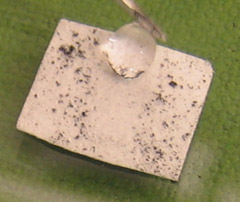In work aimed at developing superhydrophobic biofiber surfaces, polymer scientists in Sweden have shown that filter paper can be turned into a water-resistant, self-cleaning material. Water droplets roll off the surface of the paper, carrying dirt with them (Chem. Commun., 2006, 3594).
The research paper describes a facile way to transform a very hydrophilic substrate into an extremely hydrophobic one. “To the best of our knowledge, this is the first example of a superhydrophobic cellulose substrate,” says professor of coating technology Eva Malmström, who carried out the work with colleagues at the Royal Institute of Technology, in Stockholm.
Cellulose is an abundant, inexpensive, biodegradable, renewable biopolymer that exhibits good mechanical properties. But it absorbs water. The creation of superhydrophobic, self-cleaning, cellulose-fiber-based materials could have potential applications in the textile industry, Malmström suggests.
The Swedish scientists chose filter paper as their cellulose fiber substrate because of its high surface roughness. They used a process known as atom transfer radical polymerization to graft the fiber surfaces with a superhydrophobic polymer layer.
The team first immobilized a polymerization initiator, 2-bromoisobutyryl bromide, on the substrate. They then grafted glycidyl methacrylate, an epoxide monomer, onto the surface. After ring-opening of the epoxide groups, the resulting hydroxyl groups were reacted with pentadecafluorooctanoyl chloride. Fluorinated polymer brushes with a “graft-on-graft” architecture, as the authors call it, formed on the fiber surfaces.
 Self-cleaning water droplet removes carbon black powder from filter paper surface
Self-cleaning water droplet removes carbon black powder from filter paper surface
“The process results in a polymer layer covalently attached to the surface that is sufficiently thick to bring about the superhydrophobic character,” Malmström explains. “The approach is versatile and can be conducted on a variety of organic and inorganic substrates. It might also be possible to apply the technique to pattern thin papers or other biomass-based substrates and to use it for sensor applications.”
Source
Chemical & Engineering News Aug. 23, 2006.
Share
Renewable Carbon News – Daily Newsletter
Subscribe to our daily email newsletter – the world's leading newsletter on renewable materials and chemicals










